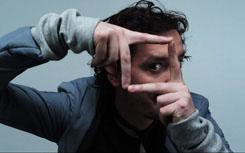Dutch band C-Mon & Kypski’s Crowdsourcing Video
(Photo courtesy: http://c-monandkypski.nl)
By Clark Boyd
The Dutch band C-Mon & Kypski have been churning out albums and touring non-stop for years now. The band’s sound — a blend of hip-hop, funk and jazz — has wowed critics in Europe. Now, one of the group’s videos has gotten the attention of some computer scientists at New York University, who are using it to train computers to see more like human beings do.
Simon Akkermans (C-Mon) and Thomas Elbers (Kypski) have been creating crazy sounds together since they were kids in Utrecht.
“We used to go skateboarding, and then when we got tired, we’d just spend hours pushing pause buttons on cassette decks, trying to make samples…sort of,” says Akkermans.
“Later that evolved into more technology, our first four track recorder, then the first sampler, and we evolved that into a kind of instrumental based, sample based hip-hop kind of music.”
Akkermans says the band’s music mixes the layered beats popular with his childhood favorites, Public Enemy, with guitars, drums, keyboards, and even sitars.
“I think there’s a pretty big sense of humor in our music as well,” says Akkermans.
“If music makes me smile, then that’s one of the goals.”
C-Mon & Kypski put a lot of that humor into their music videos, which also tend to be highly conceptual.
For one recent video, for the track “More is Less,” Akkermans says the group decided to work with a Dutch filmmaker they admired.
“He came up with this web cam idea. People could send in their own pictures, which would then be automatically put into the final video.”
They launched a website called One Frame of Fame, which presents you with one frame from the video.
You mimic the pose in the given frame, take a shot with your computer’s camera, and upload the picture to the website.
More than 30,000 people have done it so far. The result is a frenetic mix of motion and stop action, with lots of different faces and poses blending together.
The video caught Google’s attention recently. The search giant featured it is an interesting example of “crowdsourcing.”
And that’s how NYU post-doc Graham Taylor heard about it. Taylor, who is at the Courant School of Mathematical Sciences, works on machine learning and computer vision.
“Something clicked,” Taylor says, “The band had this amazing data source. So, we had to grab it, and we had to start working with it.”
Taylor and the others are trying to find algorithms that will help computers process visual data more like the human brain.
The video for “More is Less,” he says, is just about perfect.
“It has a whole bunch of people doing the same thing, but the pictures, the images looked totally different. You have different people, different backgrounds, people holding their cats in the image, and this is exactly what we needed for our algorithm.”
With the band’s permission, Taylor and the others have been refining their math using the C-Mon & Kypski video.
The goal of the research is to help build things such as better gesture-based gaming systems, or to help train computers to better detect faces in a crowd.
And the best part, Taylor says, is that people keep adding their pictures to the video project, which gives him a new set of faces and poses on which to test the model.
Taylor says he will be keeping a close eye on The Netherlands to see if C-Mon & Kypski’s next video might also contain scientific gold.
But Simon Akkermans cautions that he does not think the idea would go over as well a second time around.
Sometimes, he says, less is more.
